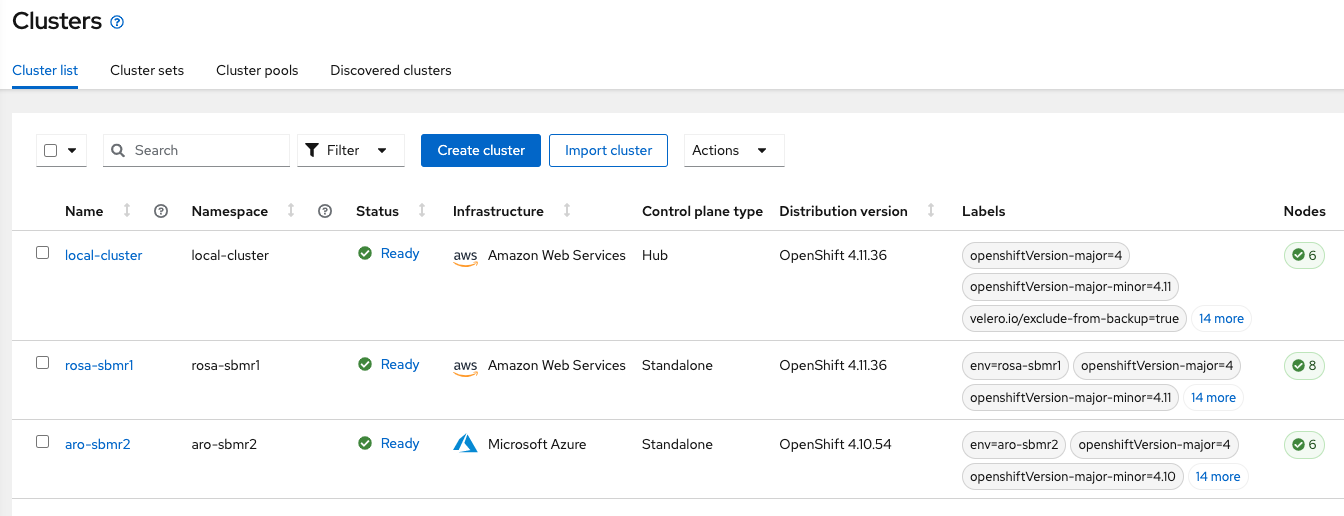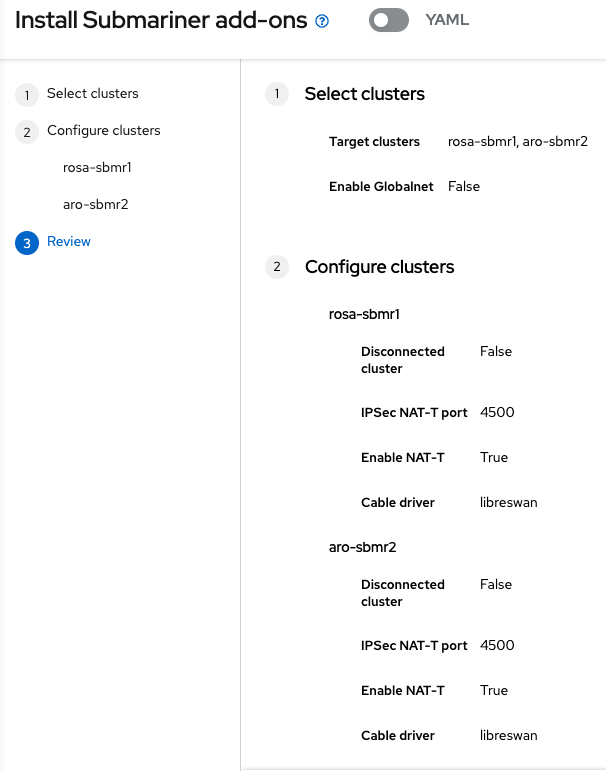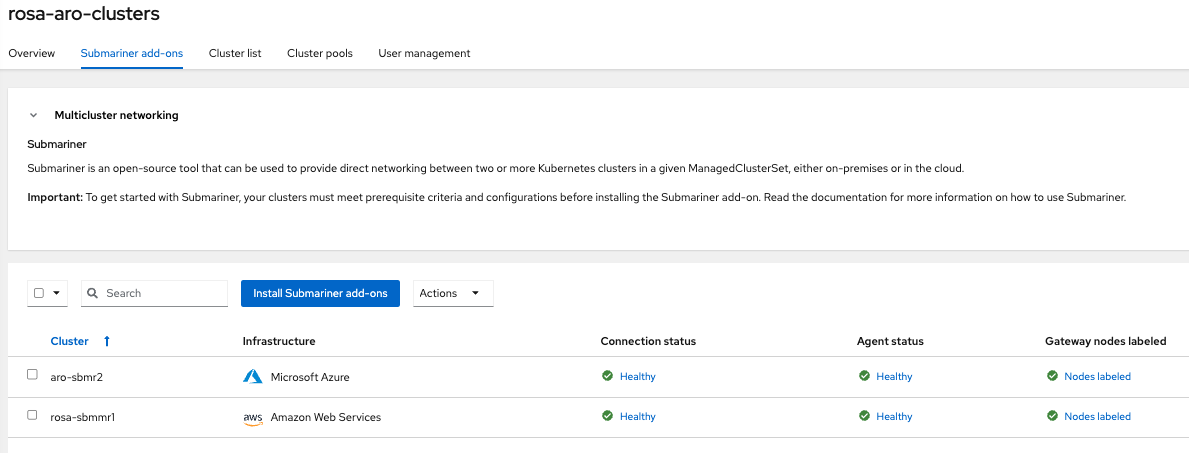Deploy ACM Submariner for connect overlay networks ARO - ROSA clusters
This content is authored by Red Hat experts, but has not yet been tested on every supported configuration.
Submariner is an open source tool that can be used with Red Hat Advanced Cluster Management for Kubernetes to provide direct networking between pods and compatible multicluster service discovery across two or more Kubernetes clusters in your environment, either on-premises or in the cloud.
This article describes how to deploy ACM Submariner for connecting overlay networks of ARO and ROSA clusters.
NOTE: Submariner for connecting ARO and ROSA clusters only works from ACM 2.7 onwards!
Prerequisites
- OpenShift Cluster version 4 (ROSA/ARO or non-ROSA/ARO)
- az cli
- rosa cli
- aws cli (optional)
Manage Multiple Logins
- In order to manage several clusters, we will add a new Kubeconfig file to manage the logins and change quickly from one context to another:
rm -rf /var/tmp/acm-lab-kubeconfig
touch /var/tmp/acm-lab-kubeconfig
export KUBECONFIG=/var/tmp/acm-lab-kubeconfig
Deploy ACM Cluster HUB
We will use the first OpenShift cluster to deploy ACM Hub.
- Login into the HUB OpenShift cluster and set the proper context
oc login --username xxx --password xxx --server=https://api.cluster-xxx.xxx.xxx.xxx.com:6443
kubectl config rename-context $(oc config current-context) hub
kubectl config use hub
- Create the namespace for ACM
cat << EOF | kubectl apply -f -
apiVersion: v1
kind: Namespace
metadata:
name: open-cluster-management
labels:
openshift.io/cluster-monitoring: "true"
EOF
- Create the OperatorGroup for ACM
cat << EOF | kubectl apply -f -
apiVersion: operators.coreos.com/v1
kind: OperatorGroup
metadata:
name: open-cluster-management
namespace: open-cluster-management
spec:
targetNamespaces:
- open-cluster-management
EOF
- Install Operator ACM 2.7
cat << EOF | kubectl apply -f -
apiVersion: operators.coreos.com/v1alpha1
kind: Subscription
metadata:
name: advanced-cluster-management
namespace: open-cluster-management
spec:
channel: release-2.7
installPlanApproval: Automatic
name: advanced-cluster-management
source: redhat-operators
sourceNamespace: openshift-marketplace
EOF
NOTE: you can select from ACM 2.7 onwards for install ACM Submariner for ROSA/ARO.
- Check that the Operator has installed successfully
kubectl get csv -n open-cluster-management
NAME DISPLAY VERSION REPLACES PHASE
advanced-cluster-management.v2.7.2 Advanced Cluster Management for Kubernetes 2.7.2 advanced-cluster-management.v2.7.1 Succeeded
NOTE: ACM Submariner for ROSA clusters only works with ACM 2.7 or newer!
- Install MultiClusterHub instance in the ACM namespace
cat << EOF | kubectl apply -f -
apiVersion: operator.open-cluster-management.io/v1
kind: MultiClusterHub
metadata:
namespace: open-cluster-management
name: multiclusterhub
spec: {}
EOF
- Check that the
MultiClusterHubis installed and running properly
kubectl get multiclusterhub -n open-cluster-management -o json | jq '.items[0].status.phase'
"Running"
NOTE: if it’s not in Running state, wait a couple of minutes and check again.
Deploy ROSA Cluster
- Define the prerequisites for install the ROSA cluster
export VERSION=4.11.36 \
ROSA_CLUSTER_NAME=rosa-sbmr1 \
AWS_ACCOUNT_ID=`aws sts get-caller-identity --query Account --output text` \
REGION=eu-west-1 \
AWS_PAGER="" \
CIDR="10.10.0.0/16"
NOTE: it’s critical that the Machine CIDR of the ROSA and ARO clusters not overlap, for that reason we’re setting different CIDRs than the out of the box ROSA / ARO cluster install.
- Create the IAM Account Roles
rosa create account-roles --mode auto --yes
- Generate a STS ROSA cluster
rosa create cluster -y --cluster-name ${ROSA_CLUSTER_NAME} \
--region ${REGION} --version ${VERSION} \
--machine-cidr $CIDR \
--sts
- Create the Operator and OIDC Roles
rosa create operator-roles --cluster ${ROSA_CLUSTER_NAME} --mode auto --yes
rosa create oidc-provider --cluster ${ROSA_CLUSTER_NAME} --mode auto --yes
- Check the status of the Rosa cluster (40 mins wait until is in ready status)
rosa describe cluster --cluster ${ROSA_CLUSTER_NAME} | grep State
State: ready
- Set the admin user for the ROSA cluster
rosa create admin --cluster=$ROSA_CLUSTER_NAME
- Login into the rosa cluster and set the proper context
oc login https://api.rosa-sbmr1.xxx.xxx.xxx.com:6443 --username cluster-admin --password xxx
kubectl config rename-context $(oc config current-context) $ROSA_CLUSTER_NAME
kubectl config use $ROSA_CLUSTER_NAME
kubectl get dns cluster -o jsonpath='{.spec.baseDomain}'
Generate ROSA New nodes for submariner
- Create new node/s that will be used to run Submariner gateway using the following command (check https://github.com/submariner-io/submariner/issues/1896 for more details)
rosa create machinepool --cluster $ROSA_CLUSTER_NAME --name=sm-gw-mp --replicas=1 --labels='submariner.io/gateway=true'
NOTE: setting replicas=2 means that we allocate two nodes for SM GW , to support GW Active/Passive HA (check Gateway Failover section ), if GW HA is not needed you can set replicas=1.
- Check the machinepools requested, including the submariner machinepool requested
rosa list machinepools -c $ROSA_CLUSTER_NAME
ID AUTOSCALING REPLICAS INSTANCE TYPE LABELS TAINTS AVAILABILITY ZONES SPOT INSTANCES
Default No 2 m5.xlarge eu-west-1a N/A
sm-gw-mp No 1 m5.xlarge submariner.io/gateway=true eu-west-1a No
- After a couple of minutes, check the new nodes generated
kubectl get nodes --show-labels | grep submariner
Deploy ARO Cluster
IMPORTANT: To enable Submariner in ROSA - ARO clusters, the POD_CIDR and SERVICE_CIDR can’t overlap between them. To avoid IP address conflicts, the ARO cluster needs to modify the default IP CIDRs. Check the Submariner docs for more information.
- Define the prerequisites for install the ARO cluster
AZR_RESOURCE_LOCATION=eastus
AZR_RESOURCE_GROUP=aro-sbmr2-rg
AZR_CLUSTER=aro-sbmr2
AZR_PULL_SECRET=~/Downloads/pull-secret.txt
POD_CIDR="10.132.0.0/14"
SERVICE_CIDR="172.31.0.0/16"
- Create an Azure resource group
az group create \
--name $AZR_RESOURCE_GROUP \
--location $AZR_RESOURCE_LOCATION
- Create virtual network
az network vnet create \
--address-prefixes 10.0.0.0/22 \
--name "$AZR_CLUSTER-aro-vnet-$AZR_RESOURCE_LOCATION" \
--resource-group $AZR_RESOURCE_GROUP
- Create control plane subnet
az network vnet subnet create \
--resource-group $AZR_RESOURCE_GROUP \
--vnet-name "$AZR_CLUSTER-aro-vnet-$AZR_RESOURCE_LOCATION" \
--name "$AZR_CLUSTER-aro-control-subnet-$AZR_RESOURCE_LOCATION" \
--address-prefixes 10.0.0.0/23 \
--service-endpoints Microsoft.ContainerRegistry
- Create machine subnet
az network vnet subnet create \
--resource-group $AZR_RESOURCE_GROUP \
--vnet-name "$AZR_CLUSTER-aro-vnet-$AZR_RESOURCE_LOCATION" \
--name "$AZR_CLUSTER-aro-machine-subnet-$AZR_RESOURCE_LOCATION" \
--address-prefixes 10.0.2.0/23 \
--service-endpoints Microsoft.ContainerRegistry
- Disable network policies on the control plane subnet
az network vnet subnet update \
--name "$AZR_CLUSTER-aro-control-subnet-$AZR_RESOURCE_LOCATION" \
--resource-group $AZR_RESOURCE_GROUP \
--vnet-name "$AZR_CLUSTER-aro-vnet-$AZR_RESOURCE_LOCATION" \
--disable-private-link-service-network-policies true
- Create the ARO cluster
az aro create \
--resource-group $AZR_RESOURCE_GROUP \
--name $AZR_CLUSTER \
--vnet "$AZR_CLUSTER-aro-vnet-$AZR_RESOURCE_LOCATION" \
--master-subnet "$AZR_CLUSTER-aro-control-subnet-$AZR_RESOURCE_LOCATION" \
--worker-subnet "$AZR_CLUSTER-aro-machine-subnet-$AZR_RESOURCE_LOCATION" \
--pod-cidr "$POD_CIDR" \
--service-cidr "$SERVICE_CIDR" \
--pull-secret @$AZR_PULL_SECRET
- Get ARO OpenShift API Url
ARO_URL=$(az aro show -g $AZR_RESOURCE_GROUP -n $AZR_CLUSTER --query apiserverProfile.url -o tsv)
- Login into the ARO cluster and set context
ARO_KUBEPASS=$(az aro list-credentials --name $AZR_CLUSTER --resource-group $AZR_RESOURCE_GROUP -o tsv --query kubeadminPassword)
- Login into the ARO cluster and set context
oc login --username kubeadmin --password $ARO_KUBEPASS --server=$ARO_URL
kubectl config rename-context $(oc config current-context) $AZR_CLUSTER
kubectl config use $AZR_CLUSTER
kubectl get dns cluster -o jsonpath='{.spec.baseDomain}'
NOTE: ARO doesn’t need to generate extra nodes to have the ACM submariner components deployed.
Create ManagedClusterSets
- Create a ManagedClusterSet for ROSA and ARO clusters
kubectl config use hub
kubectl get dns cluster -o jsonpath='{.spec.baseDomain}'
cat << EOF | kubectl apply -f -
apiVersion: cluster.open-cluster-management.io/v1beta1
kind: ManagedClusterSet
metadata:
name: rosa-aro-clusters
EOF
Import ROSA cluster in ACM (CLI)
We will import the cluster using the auto-import secret and using the Klusterlet Addon Config.
If you want to import your cluster using the RHACM UI, refer to the official Importing a managed cluster by using console documentation.
- Retrieve ROSA TOKEN the ROSA API from the ROSA cluster
kubectl config use $ROSA_CLUSTER_NAME
SUB1_API=$(oc whoami --show-server)
echo "$ROSA_CLUSTER_NAME API: $SUB1_API\n"
SUB1_TOKEN=$(oc whoami -t)
echo "$ROSA_CLUSTER_NAME Token: $SUB1_TOKEN\n"
- Config the Hub as the current context
kubectl config use hub
kubectl get dns cluster -o jsonpath='{.spec.baseDomain}'
- Create (in ACM Hub cluster)
ManagedClusterobject defining the
cat << EOF | kubectl apply -f -
apiVersion: cluster.open-cluster-management.io/v1
kind: ManagedCluster
metadata:
name: $ROSA_CLUSTER_NAME
labels:
name: $ROSA_CLUSTER_NAME
cloud: auto-detect
vendor: auto-detect
cluster.open-cluster-management.io/clusterset: rosa-aro-clusters
env: $ROSA_CLUSTER_NAME
annotations: {}
spec:
hubAcceptsClient: true
EOF
- Create (in ACM Hub cluster) auto-import-secret.yaml secret defining the the token and server from ROSA cluster:
cat << EOF | kubectl apply -f -
apiVersion: v1
kind: Secret
metadata:
name: auto-import-secret
namespace: $ROSA_CLUSTER_NAME
stringData:
autoImportRetry: "2"
token: "${SUB1_TOKEN}"
server: "${SUB1_API}"
type: Opaque
EOF
- Create and apply the
klusterletadd-on configuration file for the ROSA cluster
cat << EOF | kubectl apply -f -
apiVersion: agent.open-cluster-management.io/v1
kind: KlusterletAddonConfig
metadata:
name: $ROSA_CLUSTER_NAME
namespace: $ROSA_CLUSTER_NAME
spec:
clusterName: $ROSA_CLUSTER_NAME
clusterNamespace: $ROSA_CLUSTER_NAME
clusterLabels:
name: $ROSA_CLUSTER_NAME
cloud: auto-detect
vendor: auto-detect
cluster.open-cluster-management.io/clusterset: rosa-aro-clusters
env: $ROSA_CLUSTER_NAME
applicationManager:
enabled: true
policyController:
enabled: true
searchCollector:
enabled: true
certPolicyController:
enabled: true
iamPolicyController:
enabled: true
EOF
- Check the imported cluster in ACM
kubectl get ManagedCluster
NAME HUB ACCEPTED MANAGED CLUSTER URLS JOINED AVAILABLE AGE
local-cluster true https://api.cluster-xxxx.xxxx.xxxx.xxx.com:6443 True True 5h9m
rosa-sbmr1 true https://api.rosa-subm1.xxxx.p1.openshiftapps.com:6443 True True 1m

Import ARO cluster into ACM (CLI)
- Retrieve the ARO token and the ARO API url from the ARO cluster
kubectl config use $AZR_CLUSTER
SUB2_API=$(oc whoami --show-server)
echo "$AZR_CLUSTER API: $SUB2_API\n"
SUB2_TOKEN=$(oc whoami -t)
echo "$AZR_CLUSTER Token: $SUB2_TOKEN\n"
- Config the Hub as the current context
kubectl config use hub
kubectl get mch -A
- Create (in the Hub)
ManagedClusterobject defining the ARO cluster:
cat << EOF | kubectl apply -f -
apiVersion: cluster.open-cluster-management.io/v1
kind: ManagedCluster
metadata:
name: $AZR_CLUSTER
labels:
name: $AZR_CLUSTER
cloud: auto-detect
vendor: auto-detect
cluster.open-cluster-management.io/clusterset: rosa-aro-clusters
env: $AZR_CLUSTER
annotations: {}
spec:
hubAcceptsClient: true
EOF
- Create (in the Hub)
auto-import-secret.yamlsecret defining the the token and server from ARO cluster:
cat << EOF | kubectl apply -f -
apiVersion: v1
kind: Secret
metadata:
name: auto-import-secret
namespace: $AZR_CLUSTER
stringData:
autoImportRetry: "2"
token: "${SUB2_TOKEN}"
server: "${SUB2_API}"
type: Opaque
EOF
cat << EOF | kubectl apply -f -
apiVersion: agent.open-cluster-management.io/v1
kind: KlusterletAddonConfig
metadata:
name: $AZR_CLUSTER
namespace: $AZR_CLUSTER
spec:
clusterName: $AZR_CLUSTER
clusterNamespace: $AZR_CLUSTER
clusterLabels:
Name: $AZR_CLUSTER
cloud: auto-detect
vendor: auto-detect
cluster.open-cluster-management.io/clusterset: rosa-aro-clusters
env: $AZR_CLUSTER
applicationManager:
enabled: true
policyController:
enabled: true
searchCollector:
enabled: true
certPolicyController:
enabled: true
iamPolicyController:
enabled: true
EOF
Review the clusters imported in ACM
- Check the managed clusters in ACM
kubectl config use hub
kubectl get managedclusters
NAME HUB ACCEPTED MANAGED CLUSTER URLS JOINED AVAILABLE AGE
aro-submr2 true https://api.xxxx.xxxx.xxxx:6443 True True 2m34s
local-cluster true https://api.cluster-xxxx.xxxx.xxxx.xxxx.com:6443 True True 2d
rosa-sbmr1 true https://api.rosa-xxxx.xxxx.p1.openshiftapps.com:6443 True True 46h

Now it’s time to deploy submariner in our Managed Clusters (ROSA and ARO). Either deploy using the RHACM UI or with CLI (choose one).
Deploy Submariner Addon in Managed ROSA and ARO clusters from the RHACM UI
Inside of the ClusterSets tab, go to the
rosa-aro-clustersgenerated.Go to Submariner add-ons and Click in “Install Submariner Add-Ons”
Configure the Submariner addons adding both ROSA and ARO clusters generated:

The Submariner Add-on installation will start, and will take up to 10 minutes to finish.
Deploy Submariner Addon in Managed ROSA and ARO clusters with CLI
NOTE: All of this commands are executed in the ACM Hub cluster, not in the ACM Managed Clusters (ROSA / ARO created).
- After the
ManagedClusterSetis created, the submariner-addon creates a namespace calledmanaged-cluster-set-name-brokerand deploys the Submariner broker to it.
kubectl get ns | grep broker
default-broker Active 2d
rosa-aro-clusters-broker Active 8m1s
- Create the Broker configuration on the hub cluster in the
rosa-clusters-brokernamespace:
cat << EOF | kubectl apply -f -
apiVersion: submariner.io/v1alpha1
kind: Broker
metadata:
name: submariner-broker
namespace: rosa-aro-clusters-broker
spec:
globalnetEnabled: false
EOF
NOTE: Set the the value of globalnetEnabled to true if you want to enable Submariner Globalnet in the ManagedClusterSet.
- Check the Submariner Broker in the rosa-clusters-broker namespace:
$ kubectl get broker -n rosa-aro-clusters-broker
NAME AGE
submariner-broker 5s
- Deploy the
SubmarinerConfigfor the ROSA cluster imported:
cat << EOF | kubectl apply -f -
apiVersion: submarineraddon.open-cluster-management.io/v1alpha1
kind: SubmarinerConfig
metadata:
name: submariner
namespace: $ROSA_CLUSTER_NAME
spec:
IPSecNATTPort: 4500
NATTEnable: true
cableDriver: libreswan
loadBalancerEnable: true
EOF
- Deploy the
SubmarinerConfigfor the ARO cluster imported:
cat << EOF | kubectl apply -f -
apiVersion: submarineraddon.open-cluster-management.io/v1alpha1
kind: SubmarinerConfig
metadata:
name: submariner
namespace: $AZR_CLUSTER
spec:
IPSecNATTPort: 4500
NATTEnable: true
cableDriver: libreswan
loadBalancerEnable: true
EOF
- Deploy Submariner on the ROSA cluster:
cat << EOF | kubectl apply -f -
apiVersion: addon.open-cluster-management.io/v1alpha1
kind: ManagedClusterAddOn
metadata:
name: submariner
namespace: $ROSA_CLUSTER_NAME
spec:
installNamespace: submariner-operator
EOF
- Deploy Submariner on the ARO cluster:
cat << EOF | kubectl apply -f -
apiVersion: addon.open-cluster-management.io/v1alpha1
kind: ManagedClusterAddOn
metadata:
name: submariner
namespace: $AZR_CLUSTER
spec:
installNamespace: submariner-operator
EOF
The Submariner Add-on installation will start, and will take up to 10 minutes to finish.
Check the Status of the Submariner Networking Add-On
- Few minutes (up to 10 minutes) after we can check that the app Connection Status and the Agent Status are Healthy:

